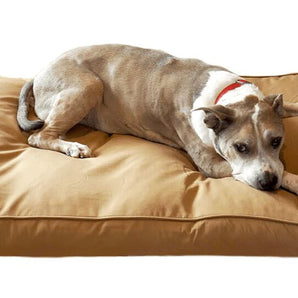Nothing beats a good outdoor adventure with your pup. Unfortunately, outdoor fun sometimes comes with the risk of picking up some unwanted passengers: ticks.
If you’re here because you’ve found a tick on your dog, don’t panic. Ticks are common, and as long as you get rid of them quickly, you can prevent your dog from getting any tick-borne diseases they may be carrying.
In this post, we’ll break down everything you need to know about how to remove a tick from a dog, what to watch for afterward, and how to help prevent tick bites in the future.
Why Ticks Are a Problem for Dogs
Ticks aren’t just creepy little bugs—they can actually be dangerous for both dogs and humans. They feed on your dog's blood and can transmit diseases such as:
-
Lyme Disease: A serious bacterial infection that can cause joint pain, fever, and tiredness.
-
Ehrlichiosis: May lead to weight loss, bleeding problems, and swollen lymph nodes.
-
Anaplasmosis: Can cause fever, lameness, and vomiting.
-
Rocky Mountain Spotted Fever: May result in fever, skin issues, and muscle pain.
The longer a tick stays attached, the higher the risk of your dog picking up one of these diseases. That’s why it’s so important to check your dog regularly and remove ticks safely and quickly.
How to Tell if Your Dog Has a Tick

Ticks are small, flat, oval-shaped parasites that can vary in size and color depending on their life stage and whether they’ve fed. Unfed ticks are typically very small—about the size of a sesame or poppy seed if they’re in the nymph stage, or closer to the size of an apple seed if they’re fully grown adults. They usually appear dark brown, reddish-brown, or black with a hard, smooth outer shell.
Sometimes, ticks are easy to spot, but other times they can hide in your dog's fur. You might feel a small bump when you pet your dog, or you might see what looks like a little mole or skin tag.
Common places ticks like to hide on dogs include:
-
Around the ears
-
Under the collar
-
Between the toes
-
Around the eyes and mouth
-
Under the tail
-
In the armpits and groin area
What You’ll Need to Remove a Tick
Before you get started, gather these items:
-
Fine-tipped tweezers or a tick twisting tool (you can find these at most pet stores)
-
Gloves (if you have them)
-
Antiseptic (like hydrogen peroxide or chlorhexidine)
-
Dog treats (because they definitely deserve a reward afterward!)
Step-by-Step: How to Safely Remove a Tick from Your Dog

Step 1: Keep Your Dog Calm and Still
Start by getting your dog into a comfortable position. Some dogs will sit or lay still without much fuss, but others may get wiggly the second you start messing with their fur.
You know your dog best—if they tend to get squirmy, ask someone to help hold them steady or distract them with soft words and gentle petting. You can also try giving them a favorite chew or frozen treat to keep their focus elsewhere. The more relaxed your dog is, the easier and safer the removal process will be for both of you.
Step 2: Find the Tick and Part the Fur
Next, carefully part your dog’s fur so you can get a clear look at the tick and how it’s attached to your pet's skin. Depending on your dog’s coat, you may need to use your fingers or a fine-tooth comb to separate the hair. Make sure you can clearly see the tick’s body and where it is attached before you attempt to remove it. Take your time—rushing here can lead to breaking the tick apart or missing part of it.
Step 3: Grasp the Tick Close to the Skin
Using a pair of fine-tipped tweezers or a specialized tick remover, grasp the tick as close to your dog’s skin as possible. It’s important to grab the tick head, not the body. Squeezing the tick’s body can push bacteria or other harmful substances into your dog’s bloodstream, increasing the risk of infection. If you’re using a tick removal tool, follow the instructions carefully—it’s designed to slide under the tick and lift it out more easily.
Step 4: Pull the Tick Out Slowly and Steadily
Once you have a firm grip, pull the tick out with slow, steady pressure. Don’t twist, jerk, or yank the tick—these actions can cause the tick’s mouthparts to break off and stay embedded in your dog’s skin. If that happens, don’t worry. You can try to gently remove the remaining piece like you would a splinter, but if you aren’t comfortable doing this, it’s always a good idea to contact your veterinarian for advice.
Step 5: Dispose of the Tick
After you’ve removed the tick, don’t just toss it in the trash or flush it down the toilet. Place the tick in a sealed container or a zip-top bag in case your veterinarian needs to see it later. If you want to be extra cautious, you can label the container with the date and where you think your dog might have picked it up. Some people prefer to preserve the tick in rubbing alcohol to kill it and keep it for identification if needed.
Step 6: Clean the Bite Area
Once the tick is removed, clean the area with antiseptic or mild soap and water to reduce the risk of infection. It’s normal to see a small bump or a bit of redness at the bite site—this usually clears up in a day or two. However, keep an eye on the area for any signs of swelling, discharge, or increased redness, which could indicate irritation or infection.
Step 7: Wash Your Hands and Reward Your Dog
Even if you wore gloves during removal, wash your hands thoroughly with soap and water. Then, celebrate your success by giving your dog plenty of praise and maybe a special treat. Tick removal isn’t exactly a fun experience for either of you, but a little reward can help make the next time a little easier (if there is a next time).
What Not to Do When Removing a Tick
While there are a lot of old-school methods floating around, some of them can actually make things worse by irritating the tick and increasing the risk of disease transmission.
Here’s what to avoid:
-
Don’t burn it off with a match or lighter.
-
Don’t smother it with petroleum jelly, essential oils, or alcohol.
-
Don’t squeeze the tick’s body.
-
Don’t twist or yank it out quickly.
What to Watch for After Tick Removal
After you remove the tick, keep an eye on your dog for the next few weeks. Call your vet if you notice:
-
Fatigue or low energy
-
Loss of appetite
-
Fever
-
Limping or joint pain
-
Vomiting or diarrhea
-
Swollen lymph nodes
-
Redness, swelling, or pus at the bite site
Catching symptoms early can make treatment much easier and more effective.
How to Help Prevent Future Tick Bites

Preventing tick bites in the first place is the best way to keep your dog safe and healthy. Thankfully, there are several simple habits you can build into your routine to lower your dog’s risk.
First, talk to your veterinarian about the right tick treatment for your dog. There are lots of options available, including monthly chewable tablets, spot-on treatments you apply to their skin, tick collars, and even natural sprays if you prefer a more chemical-free approach.
Keeping your yard well-maintained is another great tick prevention strategy. Ticks love to hide in tall grass, leaf piles, and brushy areas. Mowing your lawn regularly, clearing out weeds, and removing yard debris can make your space less inviting to ticks. If you live near woods or open fields, adding a gravel or mulch border around your yard can also help keep ticks from wandering in.
At home, don’t forget about your dog’s bed. Ticks can fall off after feeding or hide in soft surfaces. Consider getting a dog bed with cover that’s easy to wash and maintain, especially if your dog frequently plays outside. Regularly washing your dog’s bedding in hot water can help kill any ticks, fleas, or other pests that might be hanging around.
Finally, if you live in an area with heavy tick activity, you might want to consider professional pest control for your yard. Many companies offer pet-safe insect repellent that helps reduce the tick population outside your home.
Keep Your Dog Tick-Free!
Ticks are more than just a nuisance—they can pose real health risks to your dog. But with regular tick checks, safe removal techniques, and a good prevention routine, you can keep your pup protected and healthy.
Remember, if you ever feel unsure about removing a tick or your dog starts showing symptoms after a bite, don’t hesitate to contact your veterinarian. And don’t forget—comfortable, durable bedding like Bully Beds' orthopedic or non-chewable dog beds can support your dog’s health and recovery after any outdoor adventure.





